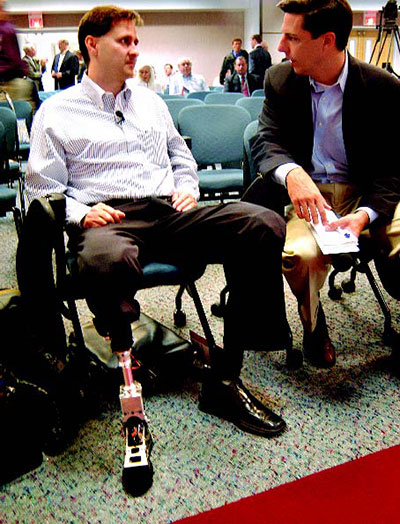It’s hard enough getting around if you’ve had a leg amputated, and it doesn’t help that the typical prosthesis sold today is so clunky. The replacement limbs don’t have joints versatile enough to let amputees walk naturally; according to researchers at MIT, it takes 30 percent more effort for someone with one of these devices to take a step than it does for a non-amputee. People with artificial legs typically complain of fatigue and the sensation that they’re going to fall over.

Several years ago, Hugh Herr, director of the Biomechatronics Research Group at the MIT Media Lab, began work on a motorized ankle-foot prosthesis that would let amputees walk even better than non-amputees. Herr had a very personal reason for undertaking the project—he lost both his lower legs in a 1982 rock-climbing accident.
In early September, Herr, who works at MIT but is part of Brown’s Center for Restorative and Regenerative Medicine, announced he’d succeeded. “With this device, an amputee could theoretically outjump someone with a normal leg,” says the Center’s director, Roy Aaron.
Here’s how it works: When we walk, ligaments and tendons absorb the impact of our foot striking the ground and use that energy to propel the foot forward. Herr’s prosthesis consists of an artificial foot and ankle equipped with springs connected to a small, battery-powered motor. The springs act like ligaments and tendons, storing the energy and then releasing it when the foot pushes off the ground. In addition, the motor generates energy, providing even more momentum to the amputee’s forward step. Aaron says using the prosthesis feels like walking on a moving sidewalk in an airport.
Most remarkable is that the prosthesis contains so-called accelerometers, a combination of tiny springs and computerized sensors capable of detecting speed, direction, and momentum. Whenever an amputee speeds up, slows down, or prepares to turn, these accelerometers adjust the joints and motor speed in the prosthesis for maximum efficiency. The amputee’s gait now becomes as natural as anyone else’s. “The problem that amputees have is that traditional prostheses don’t know what they want to do,” Aaron says. “This one does.”
With soldiers regularly coming home from the Iraq war missing limbs, the invention is particularly timely. By working with Ossur, a manufacturer based in Reykjavék, Iceland, Herr hopes to have the prostheses widely available and on the market within a year.
—Lawrence Goodman




